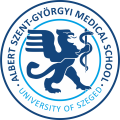University of Szeged
Albert Szent-Györgyi Medical School
Foreign Students' Secretariat
Your Education. Our Mission.
 |
| Professor Lajos Kemény — editor-in-chief: International Journal of Dermatology |
Professor Kemény lands editor-in-chief position
Dr. Lajos Kemény has become the Editor-in-Chief of a prestigious American journal - after the Mayo Clinic, the publication of the journal is now managed from the Department of Dermatology in Szeged
The US-based International Society of Dermatology has appointed Dr. Lajos Kemény, Professor of Dermatology and Immunology at the University of Szeged, as Editor-in-Chief of its official journal, the International Journal of Dermatology.
’The journal has a high professional prestige, having had its editorial board and office located in the United States since its foundation 60 years ago. The editor-in-chief and their staff were based at the Mayo Clinic for the last 23 years. This is the first time in the history of the journal that the professional management has been based outside the United States. In any case, the management of the publication does not only mean personal prestige for me, since the name of the Department of Dermatology and Allergology at the University of Szeged appears on the front page of the journal. Not to mention the fact that in the scientific correspondence of the 4500 publications received each year, my name is followed by the name of the university and the department. Those in the profession who have not been familiar it before will now look it up. The work itself is also supported by the University of Szeged, partly by providing the editorial office and partly by employing the editorial staff."
 |
| The editorial staff of the International Journal of Dermatology at the Berlin conference: Lili Beke, Prof. Lajos Kemény, Anita Biró |
The journal accepts submissions from all over the world. It once provided publication opportunities for research on tropical diseases in addition to general dermatology. Today, its focus has changed somewhat, but it continues to focus on the dermatological science of tropical underserved areas and coloured populations. The profile of the journal is therefore very broad, with a focus on the different characteristics of skin diseases in different races, but also on populations living in underprivileged conditions. It is difficult for researchers in some African or Asian countries to measure their research against international researchers: they have to compete with research coming out of American or European centres, and their publications rarely reach the major journals. We provide them with an opportunity and help these researchers.

All scientific editors at the journal work for free, because it is a prestigious job, but it is becoming increasingly difficult to find reviewers for a paper. I have been familiar with the job myself, I had an idea what to expect, still it has proved to be a bigger challenge than I thought. The day before I submitted my application, I was faced with the fact that the International Journal of Dermatology manages about 4500 publications per year. But I have always liked to read scientific articles that are not closely related to my research area, because they provide insights outside the field. It used to my hobby and now it has become my job. I read 20-25 publications a day, review the articles and keep in touch with researchers from all over the world.’






